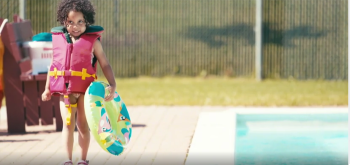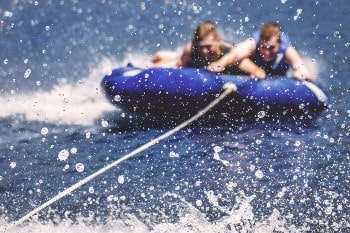By Nicole Herback, Canadian Red Cross Digital Volunteer
We’ve all seen the terms “lifejacket” and “PFD” mentioned when talking about water safety, but what many people don’t know is that the two items are different in material, level of protection, and purpose. It’s like a bike helmet and a motorcycle helmet– both have similar purposes, but different circumstances will call for more appropriate use of one over the other.

While your lifejacket and Personal Flotation Device (PFD) have their differences, it’s important to always wear them when enjoying the water for sport or leisure. Afterall, lifejacket and PFD only work if you wear them. Not everyone realizes that they are required on all personal watercrafts, including paddleboards. Often, those fishing, who do not intend on going in the water, neglect to put on a lifejacket or PFD. Every year,
161 Canadians drown while boating and only 12.5 per cent of these are wearing a lifejacket or a PFD. That's a lot of lives that could be saved!
When to use a lifejacket versus a PFD
Think of it this way: a lifejacket helps keeps you alive, and a PFD helps keeps you afloat. PFDs are designed to make constant wear more comfortable. They come in a variety of sizes so enjoying your fishing trip, recreational boating, and even paddleboarding is possible with your PFD. Lifejackets are intended to turn an unconscious person from face down to face up in the water to allow them to breathe.
Wearing a lifejacket or PFD is important, and it’s just as important to make sure it fits correctly so make sure you know
how to size your water safety gear.
Why your lifejacket is thicker than your PFD
-350-min.jpg)
Because a lifejacket is designed to turn you over and keep you afloat, the material is much thicker and bulkier than a PFD. While PFDs have less flotation than lifejackets, they come in a variety of styles and are generally smaller in size and more comfortable. Some inflatable PFDs are approved in Canada, which automatically inflate in water or can be inflated by the wearer.
Remember to always check that a lifejacket or PFD is approved in Canada on the label. Note that there are currently no inflatable PFDs that are approved for persons under 16 years of age or weighing less than 36 kilograms. If your lifejacket or PFD is not approved in Canada they are not permitted on personal watercrafts. In addition, if they are in poor condition, they are no longer considered approved.
Colour isn't a fashion statement – it's a lifesaver
Sure, your neon orange PFD might clash with your bathing suit, but there is a reason you don’t see neutral-coloured water safety gear nearly as much as its brighter counterparts. When rescuing someone from open water or in a water accident, red, yellow, and orange are the best colours for protection as they are highly visible in the water. Both the Canadian Red Cross and the Canadian Coast Guard recommend vibrant colours to ensure rescue missions are completed as quick as possible.
The importance of cleaning lifejackets and PFDs during COVID-19
In general, you should regularly inspect your lifejackets and PFDs to look for rips or signs of wear, which if found should be replaced immediately. Check its buoyancy regularly, and that all straps, buckles and zippers are in good condition. There are also important p

recautions to take during COVID-19 when it comes to wearing lifejackets and PFDs. Note that the virus can exist on clothing for up to three days, so maintaining and cleaning your water safety gear is of utmost importance.
To clean your water safety gear, use mild soap and water, rinse thoroughly, and allow it to air-dry out of direct sunlight and away from direct heat.